The New People’s Army (NPA) started in 1969. It is the armed wing of the Communist Party of the Philippines (CPP). Their main aim is to take down the government and create a communist state.
The Philippines has faced a lot of issues with communism. The NPA is one of the biggest groups involved.
The NPA has been linked to many violent acts, including the deaths of innocent people. Over time, they have changed their methods. Now, they focus on guerrilla warfare and terrorism in cities.
Even though their numbers have gone down, the NPA is still active. They are most active in Mindanao, Luzon, and the Visayas.
Key Takeaways
- The New People’s Army (NPA) was founded in 1969 as the armed wing of the Communist Party of the Philippines (CPP).
- The NPA’s primary goal is to overthrow the government and establish a communist state in the Philippines.
- The group has been involved in numerous violent incidents, including the killing of civilians.
- The NPA’s tactics have evolved over the years, with a focus on guerrilla warfare and urban terrorism.
- The NPA remains active in various regions, particularly in Mindanao, Luzon, and the Visayas.
- The Philippine government has pursued military and political solutions to address the NPA insurgency.
- The NPA has been designated as a terrorist organization by several governments, affecting its international support and funding sources.
Origins of the Communist Insurgency in the Philippines
The communist insurgency in the Philippines has a long and complex history. It started during the Spanish colonial period. Back then, economic exploitation and social injustices were common.
The encomienda system, introduced in 1570, caused a lot of discontent. It led to high taxes and abuses, making many Filipinos unhappy.
In the American colonial period, the economy favored the wealthy. This created big economic gaps. Uprisings like the “colorum” uprisings in 1923 and the “Sakdalista” revolt in 1934 showed the people’s fight for land and freedom.
The Partido Komunista ng Pilipinas (PKP) was founded in 1930. This marked the start of the communist movement in the Philippines.
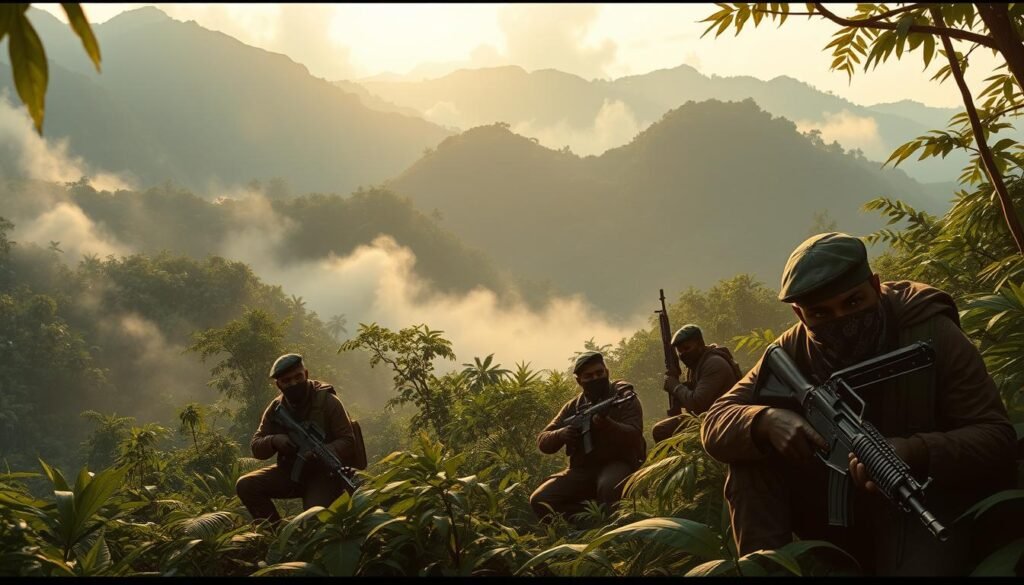
The communist insurgency in the Philippines grew stronger in the 1960s. The New People’s Army (NPA) was formed in 1969. It has been fighting against the Philippine government ever since.
This makes it one of the longest-running insurgencies in Asia. Knowing the history of the communist insurgency in the Philippines is key. It helps us understand the conflict and find ways to achieve peace and stability.
Establishment of the New People’s Army
The New People’s Army (NPA) started on March 29, 1969. It was the military wing of the Communist Party of the Philippines. At first, it had about 60 fighters.
By 1972, the NPA had grown a lot. It had 735 barrio organizing committees and controlled about 400,000 people. This marked the start of a long conflict in the Philippines.
The NPA aimed to build a strong base in rural areas. It wanted to overthrow the government. Its founding was a big deal in the Philippines’ history. It has shaped the country’s politics and society.
Today, the NPA is active in 110 guerrilla fronts across 73 provinces. This was reported by the Communist Party of the Philippines in 2018.
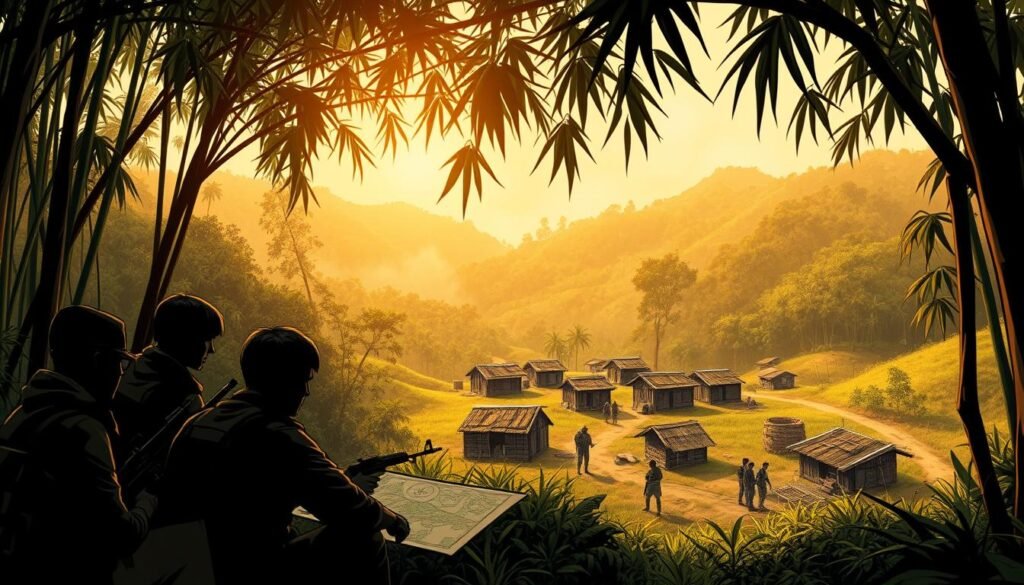
The NPA’s size has changed over time. Estimates range from 1,100 to 16,000 members. Despite being small, the NPA has a big impact in the Philippines.
Many people disagree about the NPA. Some call it a terrorist group. Others see it as a real revolutionary movement.
Some important facts about the NPA include:
- Established on March 29, 1969
- Initial formation comprised approximately 60 armed fighters
- Operates in 110 guerrilla fronts across 73 provinces in the Philippines
- Estimated size ranges from 1,100 to 16,000 members
Ideology and Political Framework
The New People’s Army (NPA) follows Maoist principles. These principles stress the need for a revolutionary movement to bring about social and economic change. The NPA aims to create a socialist system and a classless society.
The NPA’s political framework is shaped by its commitment to protracted people’s war. This approach aims to rally the masses and challenge current power structures.
The NPA also values ideological security highly. This is crucial for keeping political legitimacy and social unity. Xi Jinping believes that ideological security is a key part of political security. It helps protect political regimes and keeps society stable.
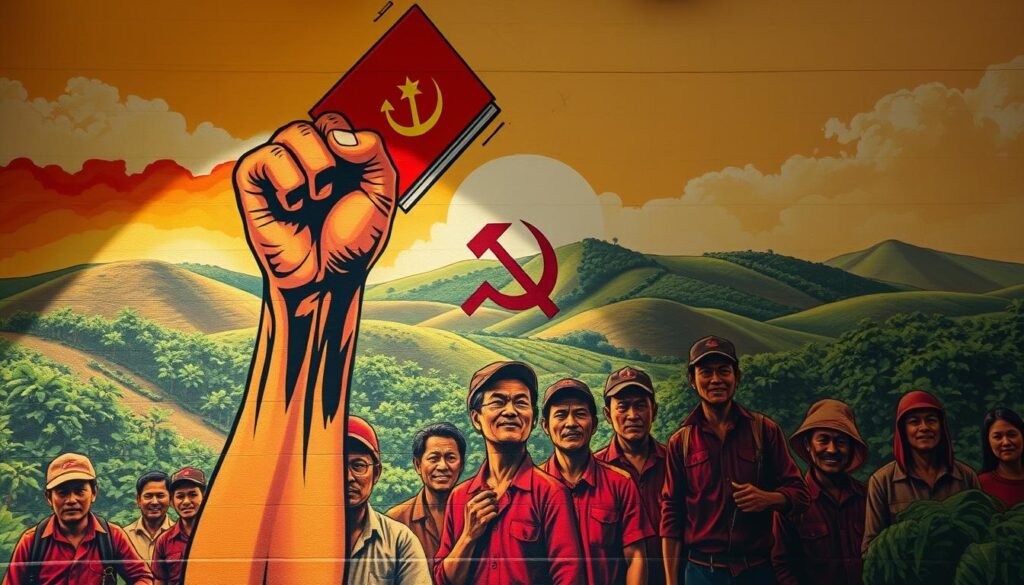
The NPA’s main goal is to set up a socialist system. They see this as a step towards true social and economic equality. They aim to challenge the current power structures and ensure resources and wealth are shared fairly.
The NPA’s political structure supports these goals. It focuses on building a strong, disciplined revolutionary movement. This movement will mobilize the masses and challenge the status quo.
Some key aspects of the NPA’s ideology and political framework include:
- A commitment to Maoist principles and the protracted people’s war
- A focus on ideological security and promoting a dominant ideology
- A commitment to establishing a socialist system and achieving social and economic equality
- A emphasis on building a strong and disciplined revolutionary movement
Geographical Presence and Strongholds
The New People’s Army (NPA) has a big geographical presence in the Philippines. It has been active in many parts of the country. The NPA is found in both rural and urban areas, especially in Leyte Island.
The government is worried about the NPA’s presence. They have set up the National Task Force to End Local Communist Armed Conflict (NTF-ELCAC). This task force started in 2018 to fight the communist insurgency. They have made good progress in reducing the NPA’s power.
Some important facts about the NPA’s decline are:
- At least 107 NPA supporters surrendered to the government in Southern Leyte in 2021.
- 59 NPA couriers, contacts, and supporters in Southern Leyte are expected to formally surrender to local authorities.
- The NPA is now at its weakest in its 55 years of existence, with the number of its combatants reduced to less than 1,500.
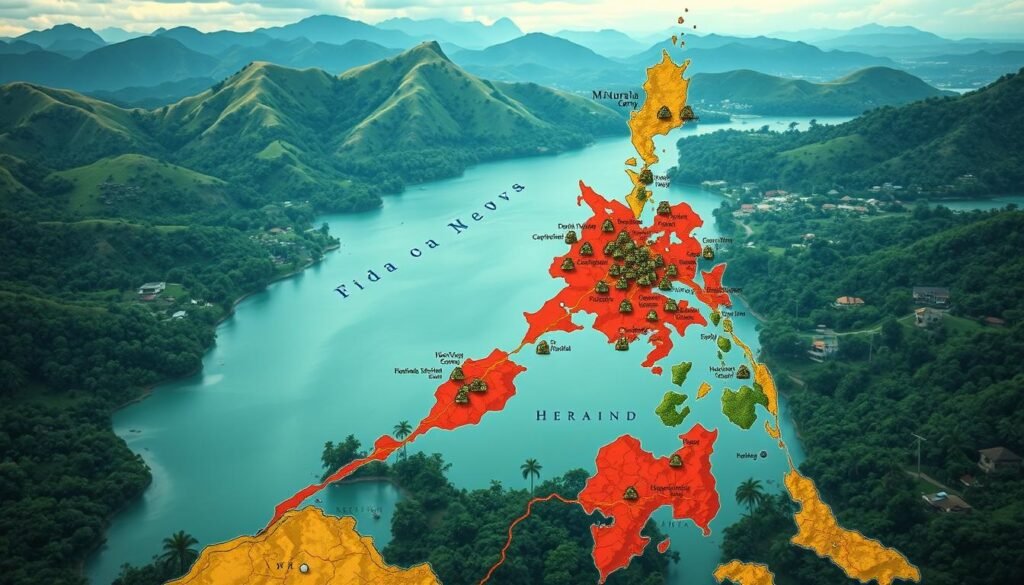
The Philippine government has made big steps to fight the NPA. The military has broken up eight and weakened 14 communist groups in the last year. Their efforts have led to better peace and order in areas once controlled by the NPA. This has opened up these areas for more tourism and investments.
Military Structure and Operations
The New People’s Army (NPA) has a military structure that supports its operations across the Philippines. Its command hierarchy helps make decisions and carry out guerrilla warfare tactics. The NPA’s ability to adjust to different settings has helped it survive and stay active.
The NPA’s military structure is known for being decentralized. This means smaller units work alone in various areas. It helps the NPA react fast to changes and surprise government forces. The NPA aims to disrupt the government’s control in rural areas, where it’s strong.
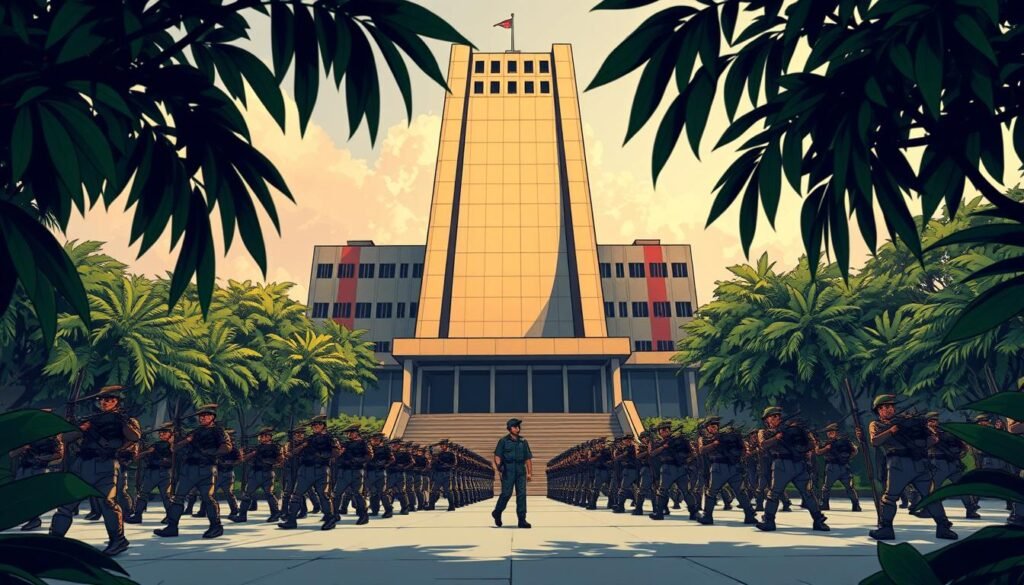
Key Aspects of NPA’s Military Structure
- Decentralized command hierarchy
- Small, independent units operating in different regions
- Ability to adapt to changing circumstances
- Focus on disrupting government control and stability in rural areas
The NPA’s guerrilla warfare tactics have been key to its survival. It blends into local communities and surprises government forces. This makes it hard for the government to wipe out the NPA.
Impact on Rural Communities
The New People’s Army (NPA) has a big impact on rural communities in the Philippines. Their presence has caused many problems, like people being forced to leave their homes. It has also disrupted economic activities and led to human rights abuses.
Many people have had to leave their homes because of the NPA. This has created a big humanitarian crisis. People are struggling to find food, shelter, and healthcare.
The NPA has been accused of serious human rights abuses. These include killings, torture, and forcing children to join their group. The Philippine government has also faced criticism for its handling of the conflict.
Some of the main effects of the NPA’s actions include:
- Displacement of residents
- Disruption of economic activities
- Human rights abuses
- Lack of access to basic necessities like food, shelter, and healthcare
The Philippine government and other groups need to work together. They must find a peaceful way to solve the conflict. This is especially important for the rural communities in the Philippines.
Relationship with the Communist Party of the Philippines
The New People’s Army (NPA) has a complex relationship with the Communist Party of the Philippines (CPP). The CPP has been active in the country since 1968. It founded the NPA as its armed wing in 1969.
The NPA and the CPP share a common goal: to establish a socialist state in the Philippines. This shared vision is the foundation of their relationship.
The CPP guides the NPA with political leadership and ideological direction. In return, the NPA carries out military operations to achieve their goals. This partnership has helped the NPA and the CPP maintain a strong presence in the Philippines, despite many challenges.
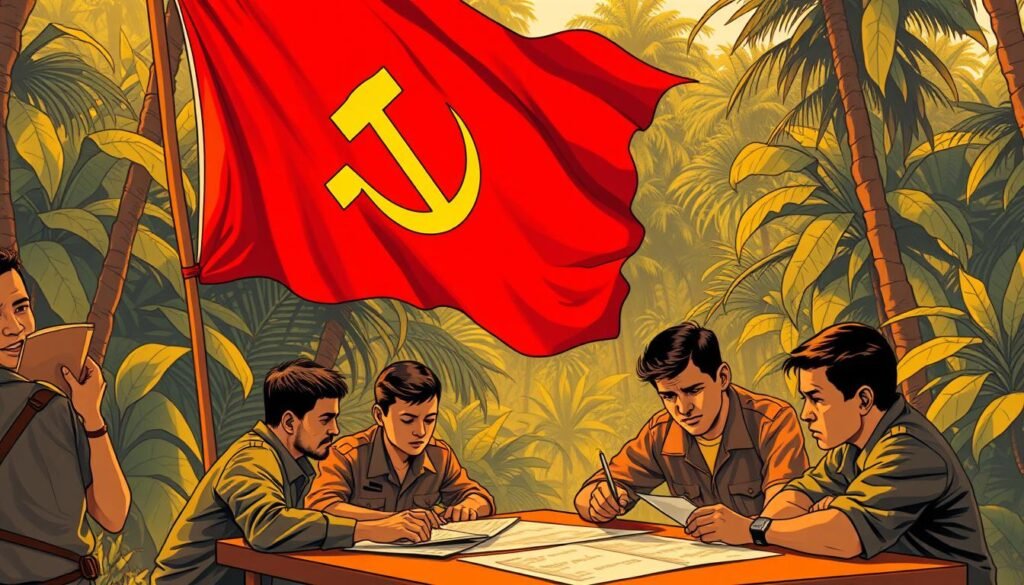
- Shared ideology and goals
- Political leadership and ideological direction
- Military operations and tactics
- Presence in the Philippines
Understanding the NPA’s relationship with the CPP is key to understanding the insurgency in the Philippines. It also helps us see the challenges the government faces in addressing this issue.
Government Response and Counter-insurgency Efforts
The Philippine government has launched counter-insurgency efforts against the New People’s Army (NPA). These actions are part of the long fight against insurgency. The government uses both military and non-military tactics, like psychological warfare and community engagement.
Examples of these efforts include creating the Bangsamoro Autonomous Region of Muslim Mindanao (BARMM) and passing the Antiterrorism Act (ATA). The government works with local groups to get people to leave insurgent groups. It also supports counter-terrorism efforts in groups around the world.
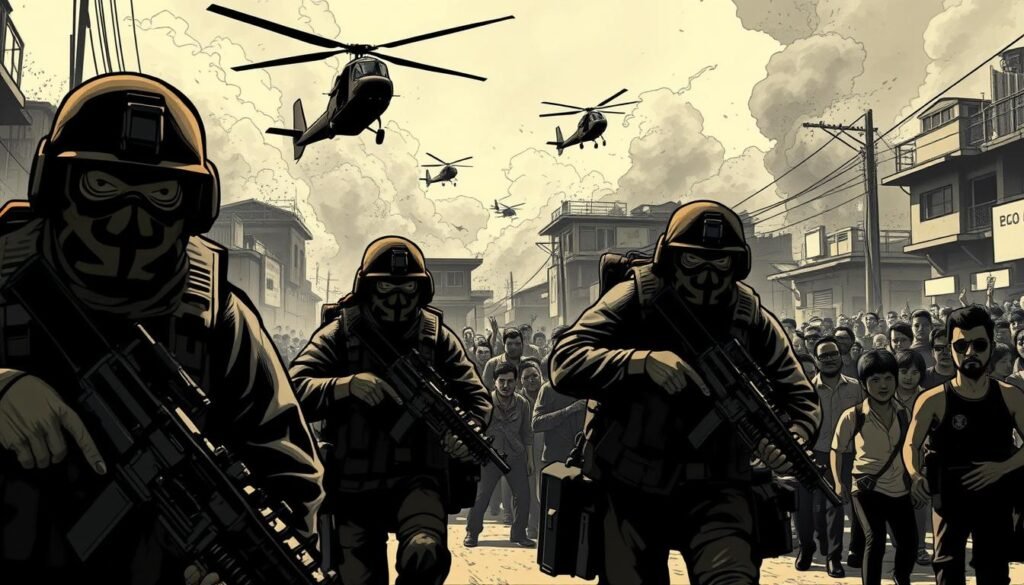
The government response to the NPA is based on past counter-insurgency experiences. The Philippines is part of groups like the Asia-Pacific Group on Money Laundering and the Egmont Group. These groups help with counter-insurgency efforts. The government’s strategies are shaped by global best practices and fit the Philippines’ unique needs.
International Relations and Support Networks
The New People’s Army (NPA) has built international relations with many foreign allies. These allies offer them support networks that help in their fight. The NPA’s foreign allies have been key, providing resources and advice to deal with international relations.
Reports say China supported the NPA with about 1,200 M-14 rifles and more in the 1970s. But China stopped helping in 2011 after a deal with the Philippines. The NPA also recruits from universities and poor areas, using their support for social causes to build a strong support network in the Philippines.
The Philippine government asked the EU and Belgium to stop funding groups linked to NPA violence. But the EU found no link in an audit on March 30. The NPA’s international relations and support networks are vital to their fight. Their ability to keep these relationships has helped them survive. For more on foreign terrorist organizations, visit the official website.
Here’s a quick look at the NPA’s international ties and support:
- Established relationships with foreign allies, including China
- Received support from foreign allies, including resources and guidance
- Established a strong support network within the Philippines
- Recruited from Philippine universities and poor regions
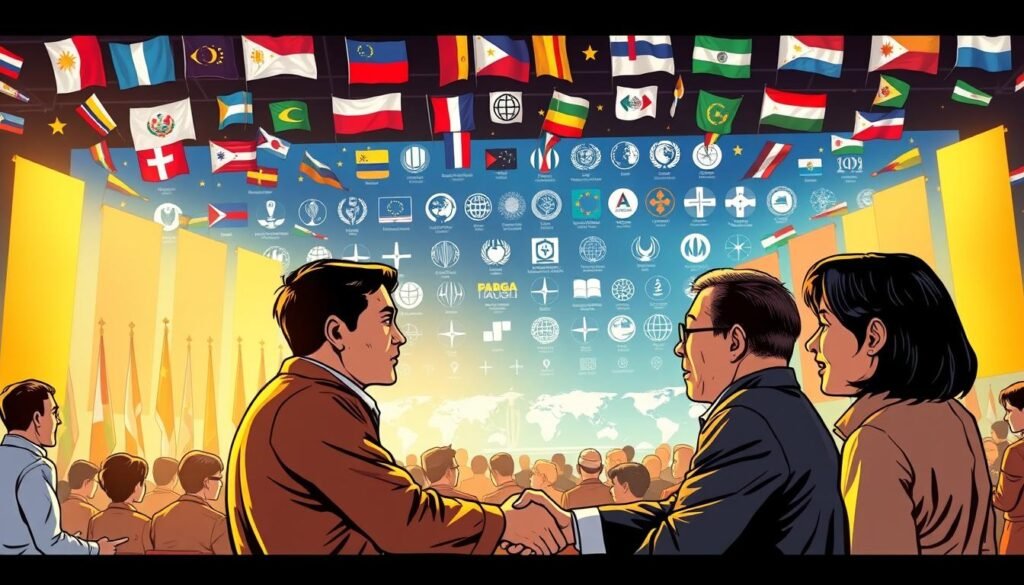
Economic Impact of NPA Activities
The economic impact of NPA activities in the Philippines is a big worry. The NPA’s actions have hurt local economies and national growth. The NPA’s insurgency has lasted for decades, affecting farming and local businesses.
The NPA’s actions have several economic effects:
- Disruptions to farming and local businesses
- More money spent on the military by the Philippine government
- Loss of lives and property in fights between the NPA and the government
The NPA’s actions have also hurt foreign investment and tourism. The economic impact of NPA activities is complex and needs a detailed solution.
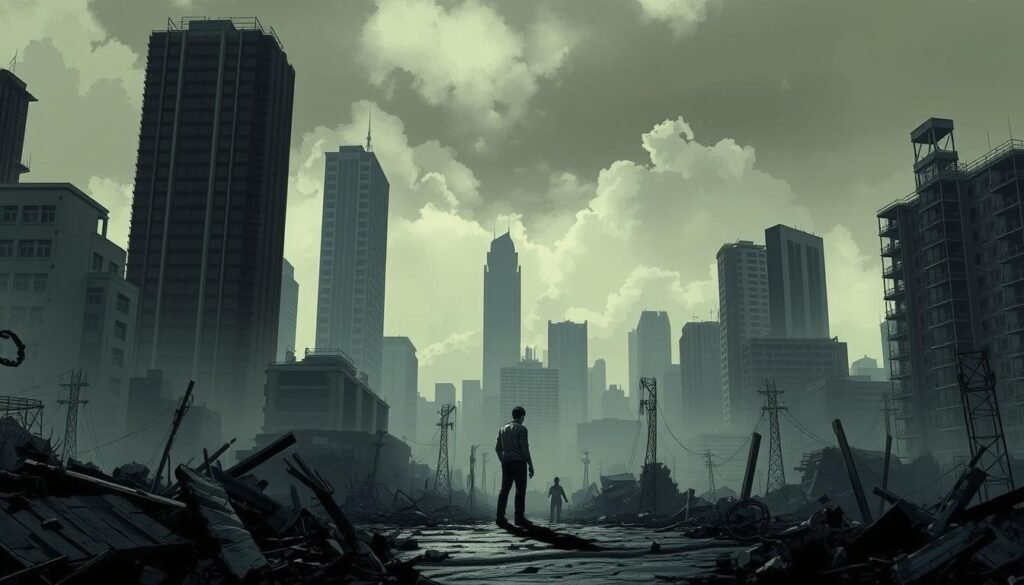
To tackle the economic effects of NPA activities, the Philippine government has taken steps. They set up the National Task Force to End Local Communist Armed Conflict (NTF-ELCAC). This task force aims to solve the insurgency’s root causes and boost economic growth in affected areas.
| Year | Economic Impact |
|---|---|
| 2019 | Disruptions to agricultural production and local businesses |
| 2018 | Increased military spending and resource allocation |
In summary, the economic impact of NPA activities in the Philippines is a major issue. The Philippine government and other groups must work together. They need to promote economic growth and tackle the insurgency’s causes.
Peace Negotiations and Agreements
The peace talks between the Philippines government and the National Democratic Front – Philippines (NDFP) have lasted almost 30 years. A key agreement is the Comprehensive Agreement on Respect for Human Rights and International Humanitarian Law (CARHRIHL). It was made as part of the peace talks. To learn more, visit the peace negotiations chronology.
The peace negotiations have faced many challenges and setbacks. Yet, the parties keep talking, hoping to solve the conflict for good. Key topics include:
- Human rights and international humanitarian law
- Socio-economic reforms
- Political and constitutional reforms
- End of hostilities and disposition of forces
The conflict has deeply affected the Philippines. It has caused about 40,000 deaths and displaced many civilians. The agreements aim to fix these problems and bring lasting peace.
Human Rights Issues and Concerns
The Philippines faces many human rights problems, especially with the New People’s Army (NPA). In 2023, at least 329 people were killed by state agents or unknown attackers. This has sparked big worries about human rights, with many demanding more accountability and openness.
Some major human rights issues include extrajudicial killings, enforced disappearances, and attacks on activists and journalists. For example, a complaint against 17 police officers for killing labor activist Emmanuel Asuncion was dismissed. He was one of nine activists killed on March 7, 2021.
There are also reports of human rights abuses by the NPA. These include using child soldiers and violence against civilians. The Department of Education found that 16 public high schools in Metro Manila were involved in NPA recruitment.
To tackle these issues, promoting respect for human rights and the law is key. This can be done through education, raising awareness, and implementing policies that protect human rights.
Current Status of the New People’s Army
The New People’s Army (NPA) is still a big deal in the Philippines. It’s known for ongoing fights and violence. Recently, the NPA killed three people in Negros Occidental in August 2023. These deaths happened after trials by the NPA’s People’s Courts, which many say don’t follow fair trial rules.
The NPA has about 4,000 members, mostly in rural areas. They get support from local communities. They’ve attacked security forces, government officials, and buildings. For more on the NPA, check out this website.
Some recent NPA actions include:
- Executing people accused of spying for the military or common crimes
- Attacking government troops and buildings
- Forcing businesses to pay “revolutionary taxes”
The Philippine government sees the NPA as terrorists. They’re trying to stop the NPA’s actions. But, the NPA is still a big worry for peace and safety in the Philippines.
Conclusion
The New People’s Army (NPA) is a big deal in the Philippines. Studies and research papers show its wide impact. It affects the economy and the government’s fight against it.
The Philippines is working to strengthen its military. But, it still has a long way to go compared to others. The country’s defense deals, like the one with the U.S., face challenges from China. The NPA plays a big role in the fight against terrorism and keeping the country safe.
In short, the NPA’s influence in the Philippines is deep and complex. Knowing about its beliefs, setup, and actions is key for those working towards peace. As the Philippines deals with its security issues, the NPA is a major factor in finding lasting peace.
FAQ
What is the New People’s Army (NPA) and its history in the Philippines?
The New People’s Army (NPA) is the armed wing of the Communist Party of the Philippines (CPP). It was founded in 1969. It has a long history of fighting in the Philippines, starting with early communist movements.
What are the NPA’s ideology and political framework?
The NPA follows Maoist principles. It aims to create a socialist state in the Philippines. Its actions are guided by the Communist Party of the Philippines.
Where is the NPA primarily located in the Philippines?
The NPA is mainly found in rural areas. This includes Luzon, Visayas, and Mindanao. It also has units in cities and operates in many provinces.
What is the NPA’s military structure and operations?
The NPA has a clear command structure. It uses guerrilla tactics like ambushes and sabotage. It also trains and recruits new members.
How does the NPA impact rural communities in the Philippines?
The NPA’s presence in rural areas has mixed effects. It offers some services but also causes displacement and human rights abuses. It disrupts the economy too.
What is the relationship between the NPA and the Communist Party of the Philippines?
The NPA is the armed wing of the Communist Party of the Philippines (CPP). They have a close relationship, with the CPP guiding the NPA.
How has the Philippine government responded to the NPA insurgency?
The government has tried many ways to fight the NPA. This includes military actions, peace talks, and development programs. It also has special task forces and intelligence units.
Does the NPA have international support and recognition?
The NPA has some foreign allies and gets recognition from leftist groups. But, most governments don’t see it as a legitimate group.
What is the economic impact of NPA activities in the Philippines?
The NPA’s actions cost the economy a lot. They cause investment loss, disrupt trade, and damage infrastructure. They also hurt agriculture and tourism.
Have there been peace negotiations and agreements between the NPA and the Philippine government?
Yes, there have been peace talks and current efforts. But, these have faced challenges like trust issues and clashes.
What human rights issues and concerns are associated with the NPA?
The NPA has been linked to human rights abuses. This includes killings, abductions, and torture. It’s also accused of using child soldiers and targeting civilians.
What is the current status of the NPA in the Philippines?
The NPA is still a big threat to peace and security in the Philippines. It has around 5,000 fighters. It continues to attack government forces and civilians.
Source Links
- Who Are the New People’s Army? The Philippines’ Forgotten War — Young Pioneer Tours
- Communist Party of the Philippines – New People’s Army
- Communist Insurgency in the Philippines
- Communist armed conflicts in the Philippines
- New People’s Army
- New People’s Army (NPA) | Encyclopedia.com
- Is the Philippines’ communist insurgency nearly over?
- Toward a More Comprehensive Analysis of Philippine Politics: Beyond the Patron-Client, Factional Framework | Journal of Southeast Asian Studies | Cambridge Core
- Ideological Security as National Security
- NPA in Leyte braces for NTF-ELCAC abolition: Army
- No more active NPA guerrilla fronts – President Marcos
- Improved peace and order in former NPA strongholds validate AFP anti-insurgency program — Brawner
- Country Reports on Terrorism 2016 – Foreign Terrorist Organizations: Communist Party of Philippines/New People’s Army (CPP/NPA) | Refworld
- AFP touts ‘strategic victory’ vs. CPP-NPA
- New People’s Army rebellion
- Communist Party of the Philippines–New People’s Army
- Best Practices in Counterinsurgency
- Philippines – United States Department of State
- Philippine Communist Rebels Grow New Aid Sources as China Steps Away
- International relations | Definition, Theory, History, Examples, & Facts | Britannica
- Terrorism in the Philippines » 2020 Global Terrorism Index
- Interview – Giving a voice to the people in the Philippines peace process
- Human rights in Philippines
- World Report 2024: Rights Trends in Philippines
- Philippines: Rebels Execute 3 After Sham Trials
- Country Reports on Terrorism 2017 – Foreign Terrorist Organizations: Communist Party of the Philippines/New People’s Army | Refworld
- Security Council Working Group adopts Philippines Conclusions – Watchlist
- The Philippines’ Security in the Face of China’s Rising Threats
- Inside Duterte’s Failed Response to the Philippines’ Communist Insurgency and the Appeal of New People’s Army among Indigenous Peoples

